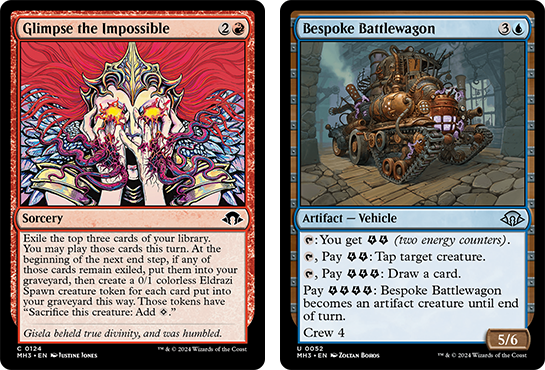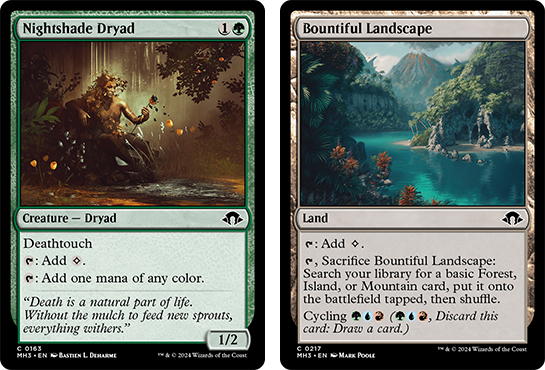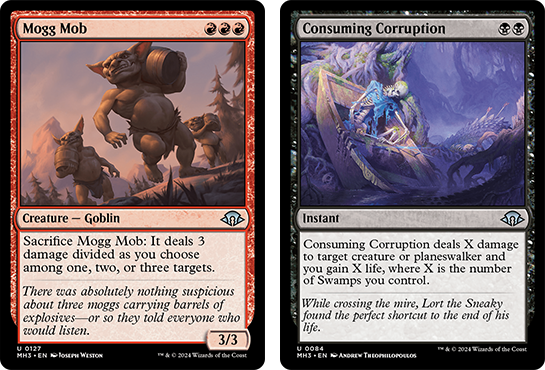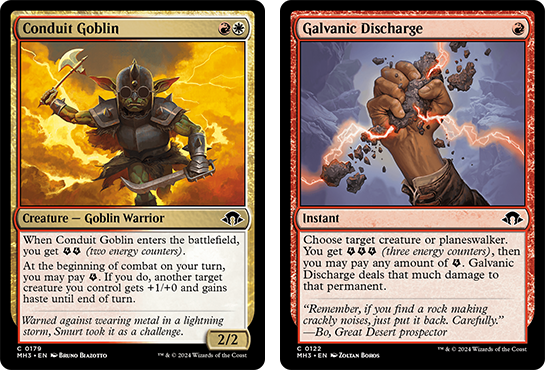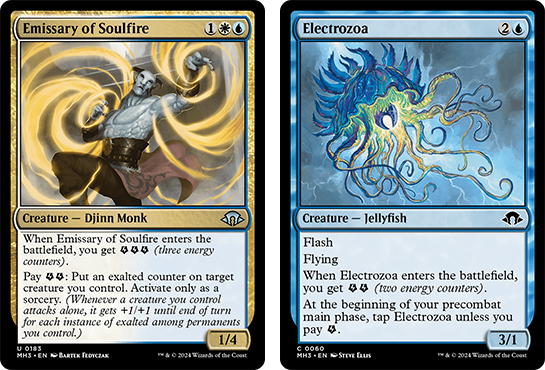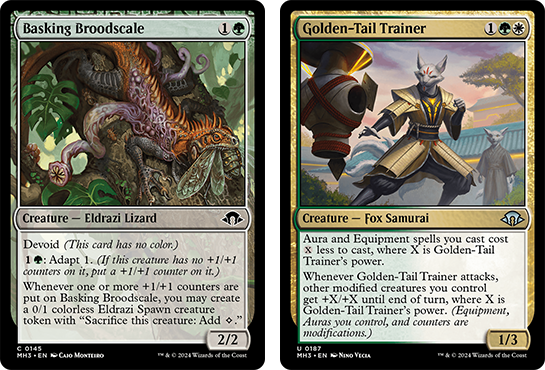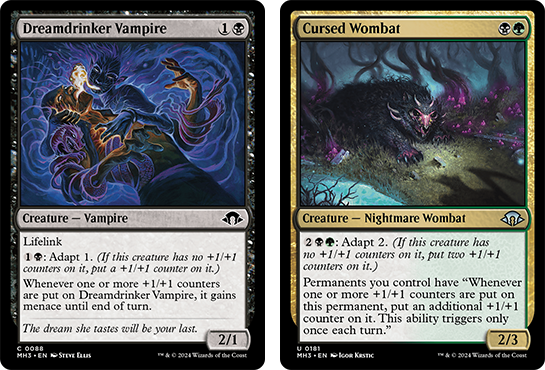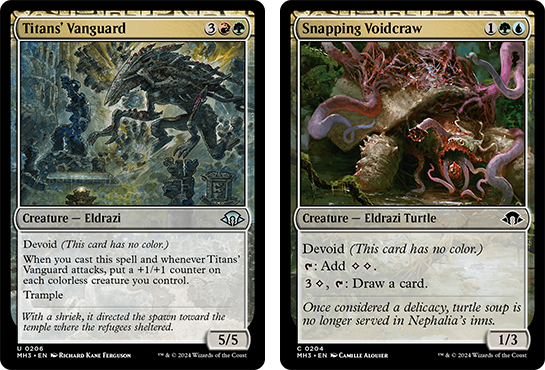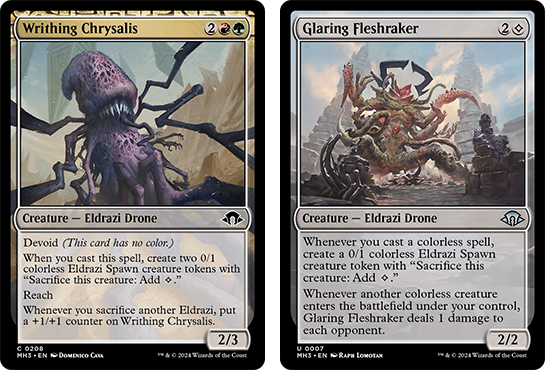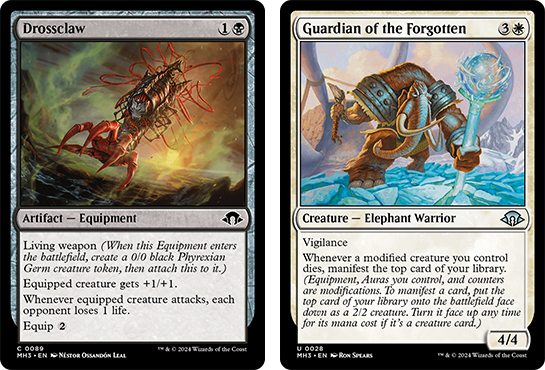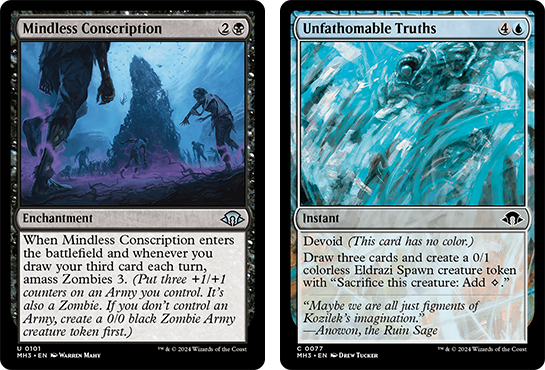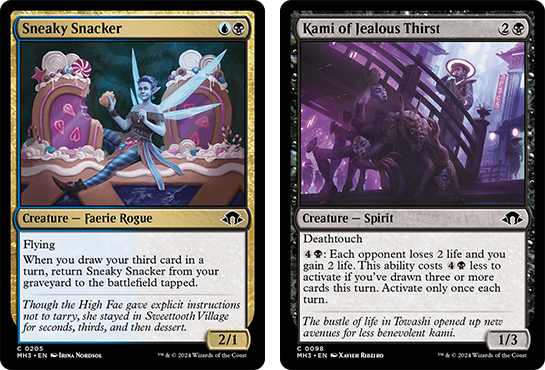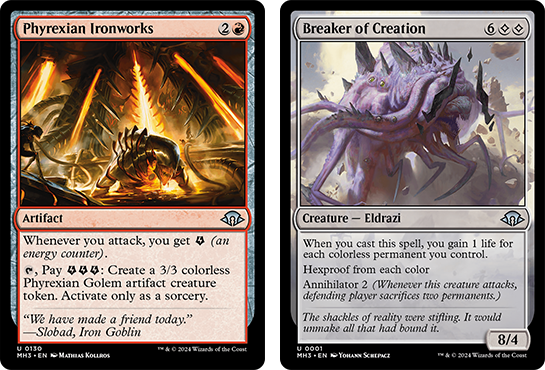The Modern Horizons sets are some of the most unique Magic products ever released, concentrating years worth of archetype support and intricate new rules into a single expansion! Modern Horizons 3 keeps that high standard going, with a Draft format that can support a range of nuanced playstyles!
Last week, I discussed how Modern Horizons approach to card and set design fundamentally changed the Limited play experience in the first two sets. That now doubles as valuable advice for anyone approaching MH3 Draft. Rather than repeat myself here, I’ll just recommend reading last week’s article as a companion to this one – and we can get right into the full Modern Horizons 3 Draft Guide!
SHAPE OF THE FORMAT
As always, we start by trying to set some “default expectations” for how average decks and matches will look in this format.
Modern Horizons 3 Drafts do feature the powerful plays you’d expect, but that does not mean games will always be quick, clean or one-sided. It does mean that you can’t simply play reactive and expect to stumble to victory. Against such high average card quality, it will take a well-defined gameplan to succeed.
In terms of other recent Draft formats, I would compare MH3 to March of the Machine.That format also had excellent mana fixing and plenty of bombs due to the guest legend slot in each pack. But it was also a slower format outside of the few designated aggro decks, with mana-intensive mechanics like transform and incubate plus Battles as a diversion from directly attacking opponents.
MH3 doesn’t go quite that far, but the plethora of high-cost creatures, ETB-tapped lands and emphasis on tricky synergies like draw-threes or sacrificing has a similar chilling effect. There ARE some very fast decks, like RW energy, but just like MOM every color has plenty of tech against small creatures commonly available.
This does start to feel like a lot of separate needs for every draft to answer simultaneously, and you can feel that pressure on every pick – even deep into pack 3! More than ever I expect that real mastery of this environment will depend on understanding which of these tools is most irreplaceable for each archetype, and which can potentially be replaced deeper in the draft.
We’ll take a closer look at what our multi-color archetypes are in a moment, but I did want to pause and acknowledge the viability of single-color drafting in MH3. While there’s plenty of fixing to unlock greedy four- and five-color decks, sticking to one color lets you focus on your other priorities when other players are squabbling over lands.
Red and Black in particular offer rewards for single-minded drafters with intensive mana costs and land-type payoffs. Mono-red has Fledgling Dragon and Furnace Hellkite, Mogg Mob, and Skoa, Embermage. Mono-black gets to maximize Consuming Corruption and Grim Servant, but really takes off if you open key rares like K’rrik, Son of Yawgmoth, Necrodominance or Shilgengar, Sire of Famine.
It’s also worth considering the potential to play a “two-color” deck where your secondary color is actually colorless. Not all the Eldrazi spells in MH3 have colorless-specific pips, but the ones which do are very strong. Sticking to a single actual color means you’re not pressured to use Landscapes for fixing, and you’ll be able to reliably harness these otherworldly threats to the fullest.
ARCHETYPE BREAKDOWN
It’s not uncommon for recent draft environments to have strong overlaps in synergy between adjacent color pairs, but MH3 takes it to another level! With excellent color fixing and fierce competition for key deck components, branching out across all three colors with a shared synergy becomes more of a necessity to ensure your needs are covered and your deck can pack the requisite punch.
I’ve decided to list these larger color groupings as they play out rather than try and translate them into the traditional two-color archetypes. I’ll try to acknowledge the more viable color variations within each one as we go.
WUR: Energy Aggro
The return of the energy mechanic has been one of the headlines for MH3 as a set, and it likewise fuels one of the dominant decks in this Draft format.
Every bit of extra efficiency and value you can squeeze out of your early turns has a massive impact on the result, which is what makes energy such a perfect mechanical fit. Even when you may not get maximum immediate use out of an Emissary of Soulfire, Unstable Amulet or Galvanic Discharge, whatever you do not use is preserved to help put a little extra mustard on the NEXT play!
Mono-red and RW are the strongest versions but any two-color pair can go far. If blue gets involved as a primary or secondary color, the profile of the deck tends to shift more towards tempo – using more interaction cards like Aether Spike and ground blockers like Emissary of Soulfire to slow down opponents while your flyers do the damage.
It’s particularly important to watch out as you draft to ensure you’re getting a useful combination of energy generators, energy payoffs and (in the case of something like Jolted Awake) suitable targets. Regardless of which colors that leads you to, your goal should be relentless pressure and an early victory before the various lategame decks can catch back up!
WBG: Modified Midrange
Another strategy that centers smaller creatures, but with more flexibility in how fast or slow you can play. Instead of always pressing pedal to the metal and relying on interaction to slip past blockers, modified decks have various ways to increase the capability of their creatures. You can go wide with +1/+1 counters and use proliferate to grow many creatures simultaneously, or go tall stacking Bestow auras to make an unstoppable single threat and smash through the lines.
Black is best as a second or third color, and shifts you more towards a classic midrange attrition plan where you’re incentivized to trade your modified creatures with opposing cards. It does still have plenty of suitable cheap attackers to contribute though – means you’re still viable if white or green end up heavily contested.
But the first preference is definitely to grab the various gold cards first – it’s easy to end up with three or more copies of Faithful Watchdog, for instance. Other key effects to prioritize are any kind of evasion, particularly synergistic effects like Temperamental Oozewagg, Nyxborn Hydra, Glasswing Grace and Wing It! If you can’t get big enough to outsize your opponent’s whole army with your best attacker, you’ll just have to go around it!
URG: Eldrazi Typal
What’s shocking about the Eldrazi in MH3 isn’t their size or lethality – that’s familiar by this point – but the sheer density of their presence in the packs. There’s just not enough big-creature removal to keep up, so you either need to bring bigger creatures of your own or end the game before they crush you.
Almost all Eldrazi decks will play green, with RG having cheaper, more aggressive cards and UG having more ramp, draw, and defense. However, it’s usually correct to play all three colors – even with the additional pressure of colorless pips on your manabase – since the synergies around devoid and eldrazi cards is so significant.
This deck is one of the best to default to, along with energy, because it has so many strong cards and can use them in almost any combination. Special shoutouts to Writhing Chrysalis for being one of the most busted commons in the last decade – immediately taking over almost any board state even on its own and completely unbeatable in multiples. There are just way, way too many Eldrazi Spawn in this set for this card to be fair!
WRB: Artifact Aristocrats
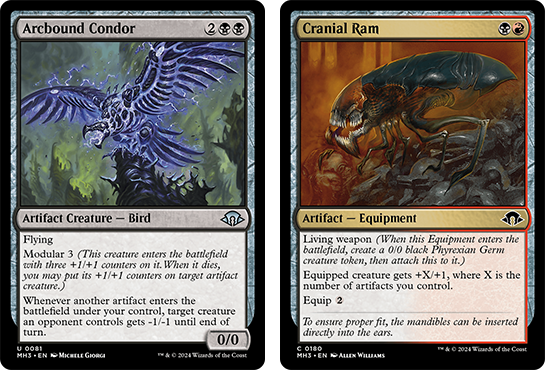
This archetype combines two synergy-focused aggro strategies which tend to underwhelm in Draft sets: sacrifice-matters and artifacts-matter. The result is… an underwhelming and inconsistent aggro deck, one which few players seem to be giving a chance when it’s so easy to put together great energy or eldrazi decks instead.
But being underplayed can become its own advantage: you’ll have very little competition for cards like Arcbound Condor, Cranial Ram, Refurbished Familiar and Frogmyr Enforcer! There are even nice spots of overlap with the other archetypes. Living weapons are the best way to farm death triggers from Ondu Knotmaster and Guardian of the Forgotten. This is also the only deck besides energy which really wants the white flicker cards like Distinguished Conjurer and Essence Reliquary, owing to its strong ETBs.
Unfortunately, the good payoffs are very focused on getting a lot of artifacts into (and out of) play, and the cheap artifacts you might use to do this are just too weak and easily stalled to become a reliable aggro deck. Meanwhile the theoretical value of building a synergy engine around sacrifice or flicker can’t really measure up to the lategame dominance of a few Eldrazi, or even the evolving army of a proliferate deck.
If you find yourself with the right rares and removal to support it, or you think you can draw multiple Cranial Rams every game, the artifact plan can lead to a winning draft. But it’s a deck I’m only moving into once I’ve seen those strong signals, rather than one I’m defaulting to from the first pack.
UB: Third-Draw Control
It must seem a little odd to have just one two-color archetype listed at the bottom here, but that’s just how the set works out. UB gives MH3 at least one traditional control deck as an alternative to the interaction-light Eldrazi plan.
In order to outscale the powerful lategames of other decks, UB relies on triggered abilities which add free value to every turn. The most significant by far is Mindless Conscription, which shares a condition with other worthy contributors like Emrakul’s Messenger, Kami of Jealous Thirst, Sneaky Snacker and Deem Inferior.
But there’s also room to weave in other engines, such as Kozilek’s Unsealing or Nesting Grounds, if the right suite of cards fall to you in the draft. The latter seems innocuous and isn’t highly taken, but is downright nasty combined with Fetid Gargantua or with sagas.
You could also treat this as more of a soft four-color deck, as you’ll certainly want to splash in any haymakers you find to help you secure the win lategame. If you don’t have that kind of firepower though, make sure you grab as many Kami of Jealous Thirst as you can! That indirect damage will chip away at opponents much more reliably than any flyers, and gives you an out to play for in many situations where you’d otherwise be doomed.
POST-MODERN (HORIZONS) SENSIBILITY
That’s the crux of what I’ve learned from the first week or so of drafting this format, but it certainly feels like there’s a lot more left to understand about MH3. Yes, for those chasing wins it feels a bit like Eldrazi vs. Energy on repeat for now. But at least both those archetypes are quite flexible in practice, with different color variants and a lot of interesting play patterns possible for each of them.
The (perceived) archetype imbalance has been reminding me of Ikoria Draft: which ultimately, many players stuck with despite living in the massive shadow of the RW cycling deck. Even if there’s no secret revelation coming which will make Writhing Chrysalis feel less busted or the RB deck more playable, that doesn’t preclude us from enjoying Modern Horizons Draft weirdness to the fullest extent!
After all, one of the cool things about Draft is how it softens any perceived balance issues. The strongest cards and decks will have their ceiling lowered as they are more fiercely contested within a pod – but nothing can help a set if the cards aren’t cool to play with. Fortunately, the cool factor is something this unusual, powerful Draft format has on tap.

Tom’s fate was sealed in 7th grade when his friend lent him a pile of commons to play Magic. He quickly picked up Boros and Orzhov decks in Ravnica block and has remained a staunch white magician ever since. A fan of all Constructed formats, he enjoys studying the history of the tournament meta. He specializes in midrange decks, especially Death & Taxes and Martyr Proc. One day, he swears he will win an MCQ with Evershrike. Ask him how at @AWanderingBard, or watch him stream Magic at twitch.tv/TheWanderingBard.


